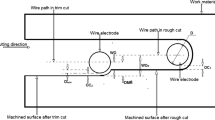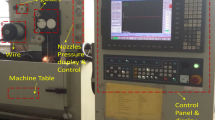Abstract
In recent years, Ti-6Al-4V (titanium alloy grade 5) is found to be one of the most widely used materials for successful applications in aerospace, automotive, and biomedical industries because of its excellent mechanical and thermal properties, outstanding corrosion resistance, and low modulus of elasticity. However, the machining of Ti-6Al-4V by conventional machining processes has always been a challenge. This study will present a comparative experimental investigation on the micro-electro-discharge machining (micro-EDM) machinability of difficult-to-cut Ti-6Al-4V against easy-to-machine brass materials. As both materials are electrically conductive, they are machinable using micro-EDM process irrespective of their hardness. It was hypothesized that the machining performance as well as quality of micro-features would vary because of the significant differences in thermal and electrical properties of two materials. In this study, the machinability of the two materials was evaluated based on the quality of the micro-features produced by the micro-EDM. Both blind and through micro-holes and micro-slots were machined on brass and Ti-6Al-4V materials. The quality of micro-features was assessed based on the dimensional accuracy, surface finish, and profile accuracy of the features. In addition, the arrays of micro-features were machined and micro patterning was done in both materials to compare the mass production capability of micro-EDM process on those materials. It was found that the dimensional accuracy of the micro-features on the Ti-6Al-4V was slightly inferior compared to those on brass due to significantly higher tool electrode wear during machining of titanium alloy. The machined surface of the micro-features in Ti-6Al-4V was found to suffer from resolidification of molten debris, whereas micro-features on brass was found to produce smoother surface finish. Both brass and Ti-6Al-4V materials were found to produce arrays of micro-features successfully, although the micro-features on Ti-6Al-4V had debris attached to the edge and surface. The study also investigated the causes associated with the challenges in micro-EDM of Ti-6Al-4V.
Similar content being viewed by others
References
Ezugwu EO, Wang ZM (1997) Titanium alloys and their machinability—a review. J Mater Process Technol 68:262–274
Li L, Chang H, Wang M, Zuo DW, He L (2004) Temperature measurement in high speed milling of Ti-6Al-4V. Key Eng Mater 259–260:804–808
Ezugwu EO, Da Silva RB, Bonney J, Machado AR (2005) Evaluation of the performance of CBN tools when turning Ti-6Al-4V alloy with high pressure coolant supplies. Int J Mach Tools Manuf 45(9):1009–1014
Bhaumik SK, Divakar C, Singh AK (1995) Machining of Ti-6Al-4V alloy with a wBN-cBN composite tool. Mater Des 16(4):221–226
Su Y, He L, Li L, Li XL (2006) An experimental investigation of effects of cooling/lubrication conditions on tool wear in high speed end milling of Ti-6Al-4V. Wear 261:760–766
Tsai Y-Y, Masuzawa T (2004) An index to evaluate the wear resistance of the electrode in micro-EDM. J Mater Process Technol 149:304–309
Ho KH, Newman ST (2003) State of the art electrical discharge machining (EDM). Int J Mach Tools Manuf 43:1287–1300
Fonda P, Wang Z, Yamazaki K, Akutsu Y (2008) A fundamental study on Ti-6Al-4V’s thermal and electrical properties and their relation to EDM productivity. J Mater Process Technol 202:583–589
Hasçalık A, Çaydaş U (2007) A comparative study of surface integrity of Ti–6Al–4V alloy machined by EDM and AECG. J Mater Process Technol 190:173–180
Kao JY, Tsao CC, Wang SS, Hsu CY (2010) Optimization of the EDM parameters on machining Ti–6Al–4V with multiple quality characteristics. Int J Adv Manuf Technol 47:395–402
Kumar A, Kumar V, Kumar J (2013) Multi-response optimization of process parameters based on response surface methodology for pure titanium using WEDM process. Int J Adv Manuf Technol 68:2645–2668
Kuriakose S, Shunmugam MS (2004) Characteristics of wire-electro discharge machined Ti6Al4V surface. Mater Lett 58:2231–2237
Ningsong Q, Xiaolong F, Wei L, Yongbin Z, Di Z (2013) Wire electrochemical machining with axial electrolyte flushing for titanium alloy. Chin J Aeronaut 26(1):224–229
Nourbakhsh F, Rajurkar KP, Malshe AP, Cao J (2013) Wire electro-discharge machining of titanium alloy. Proc CIRP 5:13–18
Alias A, Abdullah B, Abbas NM (2012) Influence of machine feed rate in WEDM of titanium Ti-6Al-4V with constant current (6A) using brass wire. Proc Eng 41:1806–1811
Harcuba P, Baˇcáková L, Stráský J, Baˇcáková M, Novotná K, Janeˇcek M (2012) Surface treatment by electric discharge machining of Ti–6Al–4V alloy for potential application in orthopaedics. J Mech Behav Biomed Mater 7:96–105
Stráský J, Janeˇcek M, Harcuba P, Bukovina M, Wagner L (2011) The effect of microstructure on fatigue performance of Ti–6Al–4V alloy after EDM surface treatment for application in orthopedics. J Mech Behav Biomed Materi 4:1955–1962
Aspinwall DK, Soo SL, Berrisford AE, Walder G (2008) Workpiece surface roughness and integrity after WEDM of Ti–6Al–4V and Inconel 718 using minimum damage generator technology. CIRP Ann Manuf Technol 57:187–190
Ndaliman MB, Khan AA, Ali MY (2013) Influence of electrical discharge machining process parameters on surface micro-hardness of titanium alloy. Proc IMechE Part B: J Eng Manuf 227(3):460–464
Singh SK, Kumar N, Kumar A (2014) Experimental investigations of EDM to optimize surface roughness of titanium alloy (Ti-6AL-4V) through Taguchi’s technique of design of experiments. Int J Curr Eng Technol 4(1):84–87
Lin YC, Yan BH, Chang YS (2000) Machining characteristics of titanium alloy (Ti-6Al-4V) using a combination process of EDM with USM. J Mater Process Technol 104:171–177
Gu L, Li L, Zhao W, Rajurkar KP (2012) Electrical discharge machining of Ti6Al4V with a bundled electrode. Int J Mach Tools Manuf 53:100–106
Tiwary AP, Pradhan BB, Bhattacharyya B (2015) Study on the influence of micro-EDM process parameters during machining of Ti–6Al–4V superalloy. Int J Adv Manuf Technol 76(1–4):151–160
Meena VK, Azad MS (2002) Grey relational analysis of microEDM machining of Ti6Al4V alloy. Mater Manuf Process 27(9):973–977
Kuriachen B, Mathew J (2014) Modeling of material removal mechanism in micro electric discharge milling of Ti-6Al-4V. Appl Mech Mater 592–594:516–520
Sivaprakasam P, Hariharan P, Gowri S (2014) Modeling and analysis of micro-WEDM process of titanium alloy (Ti-6Al-4V) using response surface approach. Eng Sci Technol Int J 17:227–235
Kumar, A (2012) Modeling of micro wire electro discharge machining in aerospace material. Department of Mechanical Engineering, National Institute of Technology Rourkela −769 008 (India)
Kibria G, Sarkar BR, Pradhan BB, Bhattacharyya B (2010) Comparative study of different dielectrics for micro-EDM performance during microhole machining of Ti-6Al-4V alloy. Int J Adv Manuf Technol 48:557–570
Ali MY, Rahman NABA, Aris EBM (2011) Powder mixed micro electro discharge milling of titanium alloy: investigation of material removal rate. Adv Mater Res 383–390:1759–1763
Kuriachen B, Mathew J (2015) Effect of powder mixed dielectric on material removal and surface modification in micro electric discharge machining of Ti6Al4V. Mater Manuf Process. doi:10.1080/10426914.2015.1004705
Jahan MP, Asad ABMA, Rahman M, Wong YS, Masaki T (2011) Micro-electro discharge machining (μEDM). In: M. Koc and T. Ozel (eds.) Micro-manufacturing: Design and manufacturing of micro-products. Chapter 10, John Willey and Sons, Inc, 301–346
D’Urso G, Merla C (2014) Workpiece and electrode influence on micro-EDM drilling performance. Precis Eng 38(4):903–914
Bauer W, Müller M, Knitter R, Oerding J, Albers A, Kotschenreuther J, Fleischer J (2008) Development and prototyping of a ceramic micro turbine. In proceedings of 4th International Conference & Exhibition on Ceramic Interconnect & Ceramic Microsystems Technologies CICMT 2008, April 21–24, 2008. Munich, Germany, 000246–000253
Ananthanarayanan A, Gupta SK, Bruck HA, Yu Z, Rajurkar KP (2007) Development of in-mold assembly process for realizing mesoscale revolute joints. In: Proceedings of North American Manufacturing Research Conference, Ann Arbor, MI, May 2007
Jun Q (2002) Development of cylindrical wire electrical discharge machining process and investigation of surface integrity and mechanical property of EDM surface layers. PhD thesis, Department of Mechanical Engineering, North Carolina State University, Raleigh, North Carolina
Chern GL, Chuang Y (2006) Study on vibration-EDM and mass punching of micro-holes. J Mater Process Technol 180(1–3):151–160
Gianchandani YB, Takahata K (2003) Micro-electro-discharge machining utilizing semiconductor electrodes, United States Patent # US 6,586,699 B1
Jahan MP, Wong YS, Rahman M (2009) A study on the quality micro-hole machining of tungsten carbide by micro-EDM process using transistor and RC-type pulse generator. J Mater Process Technol 209(4):1706–1716
Jahan MP, Wong YS, Rahman M (2010) A comparative experimental investigation of deep-hole micro-EDM drilling capability for cemented carbide (WC-Co) against austenitic stainless steel (SUS 304). Int J Adv Manuf Technol 46(9–12):1145–1160
Author information
Authors and Affiliations
Corresponding author
Rights and permissions
About this article
Cite this article
Moses, MD., Jahan, M.P. Micro-EDM machinability of difficult-to-cut Ti-6Al-4V against soft brass. Int J Adv Manuf Technol 81, 1345–1361 (2015). https://doi.org/10.1007/s00170-015-7306-9
Received:
Accepted:
Published:
Issue Date:
DOI: https://doi.org/10.1007/s00170-015-7306-9




